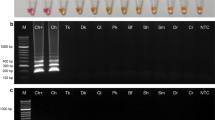Abstract
The verification of declared components in meat products is an essential task of food control agencies worldwide. To date, the ELISA and species-specific polymerase chain reaction (PCR) are two commonly applied analytical tools employed by many authorized food control laboratories. These trusted methods however do not allow the simultaneous detection of all the animal species present in a meat sample. Additionally, detection of undeclared components resulting from inadvertent contamination or deliberate adulteration of the meat products requires additional processing of the samples, resulting in increased expenditure. The use of DNA biochip analysis that allows simultaneous processing of many meat products, while concomitantly generating results for the detection of all animal species present in the meat products is thus highly desirable. In this work, two commercially available animal chip detection systems (CarnoCheck Test Kit and MEATspecies LCD Array) are compared in terms of sensitivity, robustness, reproducibility, and ease of handling. The two animal species differentiation biochip methods compared well in efficiency and could simultaneously detect from eight to 14 animal species in the meat products. Detection limits were found to be in the range of 0.1% to 0.5% in meat admixtures, with good reproducibility of results. More than 70 commercially available meat samples were analyzed in this work, with the results validated against traditional PCR methodology. Both biochip methods performed well and could be implemented for routine use in any food control agency.


Similar content being viewed by others
References
Arslan A, Irfan Ilhak O, Calicioglu M (2006) Effect of method of cooking on identification of heat processed beef using polymerase chain reaction (PCR) technique. Meat Sci 72:326–330
Bai W, Xu W, Huang Y, Cao S, Luo Y (2009) A novel common primer multiplex PCR (CP-M-PCR) method for the simultaneous detection of meat species. Food Control 20:366–370
Chikuni K, Tabata T, Kosugiyama M, Monma M, Saito M (1994) Polymerase chain reaction assay for detection of sheep and goat meats. Meat Sci 37:337–345
Chipron (2005) DNA based identification of meat and poultry species. Data Sheet Meat Species 1.6. Manual V-I-08
Commission Directive 2002/86/EC. L 305/19. 2002. Official Journal of the European Communities
Commission Recommendation 2004/787/EC. L 348/18. 2004. Official Journal of the European Union
Greiner Bio-One (2005) CarnoCheck test kit for the detection of animal species in food. Manual, Version BQ-005-03
Hsing-Mei H, Hsiao-Ling C, Li-Chin T, Shu-Ya L, Nu-en H, Linacre A, James Chun-I L (2001) Cytochrome b gene for species identification of the conservation animals. Forensic Sci Int 122:7–18
Kemp JT, Davis RW, White RL, Wang SX, Webb CD (2005) A novel method for STR-based DNA Profiling using microarrays. J Forensic Sci 50:1109–1113
Kocher TD, Thomas WK, Meyer A, Edwards SV, Paabo S, Villablanca FX, Wilson AC (1989) Dynamics of mitochondrial DNA evolution in animals: Amplification and sequencing with conserved primers. Proc Natl Acad Sci U S A 86:6196–6200
Köppel R, Ruf J, Zimmerli F, Breitenmoser A (2008) Multiplex real-time PCR for the detection and quantification of DNA from beef, pork, chicken and turkey. Eur Food Res Technol 227:1199–1203
Köppel R, Zimmerli F, Breitenmoser A (2009) Heptaplex real-time PCR for the identification and quantification of DNA from beef, pork, chicken, turkey, horse meat, sheep (mutton) and goat. Eur Food Res Technol 230:125–133
Laube I, Spiegelberg A, Butschke A, Zagon J, Schauzu M, Kroh L, Broll H (2003) Methods for the detection of beef and pork in foods using real-time polymerase chain reaction. Int J Food Sci Technol 38:111–118
Laube I, Tagon J, Broll H (2007) Quantitative determination of commercially relevant species in foods by real-time PCR. Int J Food Sci Technol 42:336–341
Ling W-F, Hwang D-F (2008) A multiplex PCR assay for species identification of raw and cooked bonito. Food Control 19:879–885
Mane BG, Mendiratta SK, Tiwari Bhilegaokar KN, Ravindra PV, Rautt AA (2007) Precise and rapid identification of ovine-caprine origin of meat by specific PCR assay. J Vet Public Health 5:107–111
Mane BG, Mendiratta SK, Tiwari AK (2009) Polymerase chain reaction assay for identification of chicken in meat and meat products. Food Chem 116:806–810
Matsunaga T, Chikuni K, Tanabe R, Muroya S, Shibata K, Yamada J, Shinmura Y (1999) A quick and simple method for the identification of meat species and meat products by PCR assay. Meat Sci 51:143–148
Meyer R, Candrian U, Luethy J (1994) Detection of pork in heated meat Products by polymerase chain reaction. J AOAC Int 77(3):617–622
Nau F, Désert C, Cochet M-F, Pasco M, Jan S, Baron F, Lagarrigue S, Guérin-Dubiard C (2009) Detection of turkey, duck, and guinea fowl egg in hen egg products by species-specific PCR. Food Anal Methods 2:231–238
Radkey R, Feng L, Muralhider M, Duhon M, Canter D, DiPierro D, Fallon S, Tu E, McElfresh K, Nerenberg M, Sosnowski R (2000) Rapid, high fidelity analysis of simple sequence repeats on an electronically active DNA microchip. Nucleic Acids Res 28(7):E17
Stueber E (2008) Comparion of three commercial test kits for species identification in scalding sausages. Arch fuer Lebensmittelhyg 59:84–91, Archives of Food Chemistry, German
Willse A, Straub TM, Wunschel SC, Small JA, Call DR, Daly DS, Chandler DP (2004) Quantitative oligonucleotide microarray fingerprinting of Salmonella enterica isolates. Nucleic Acids Res 32:1848–1856
Wintero AK, Thomsen PD, Davies W (1990) A comparison of DNA hybridization, countercurrent immunoelectrophoresis and isoelectric focussing for detecting the admixture of pork to beef. Meat Sci 27:75–91
Wolf H, Gaede W, Wolf C, Zellerman S, Hoeber S (2001) Nachweis von Tierischen Bestandteilen im Mischfutter. Fleischwirtschaft 81(5):197–201
Zipfel W, Zipfel G (2000) Lebensmittelrecht Textsammlung, 82. Ergänzungslieferung, C. H. München: Beck'sche-Verlagsbuchhandlung (in German)
Author information
Authors and Affiliations
Corresponding author
Rights and permissions
About this article
Cite this article
Iwobi, A.N., Huber, I., Hauner, G. et al. Biochip Technology for the Detection of Animal Species in Meat Products. Food Anal. Methods 4, 389–398 (2011). https://doi.org/10.1007/s12161-010-9178-9
Received:
Accepted:
Published:
Issue Date:
DOI: https://doi.org/10.1007/s12161-010-9178-9




